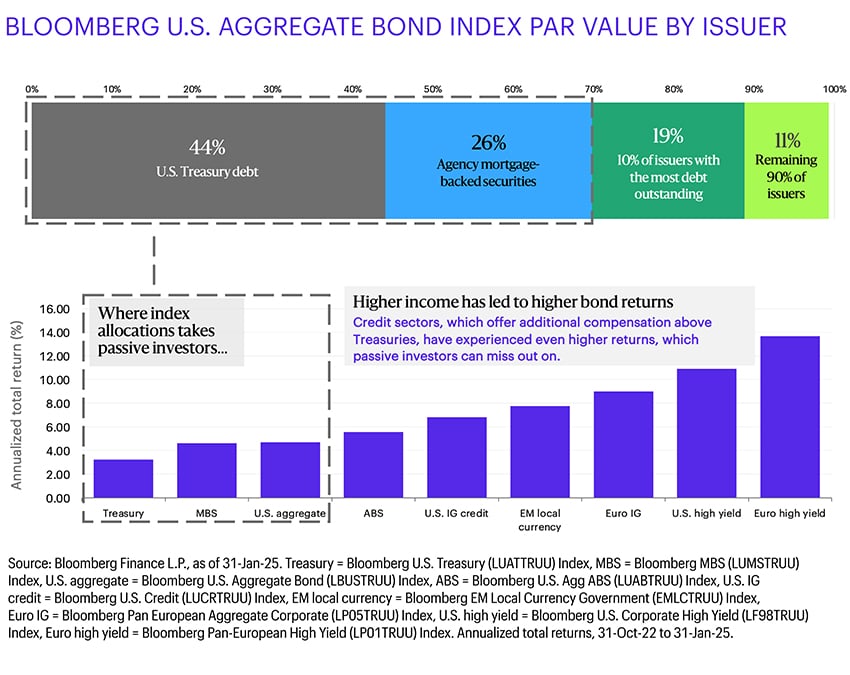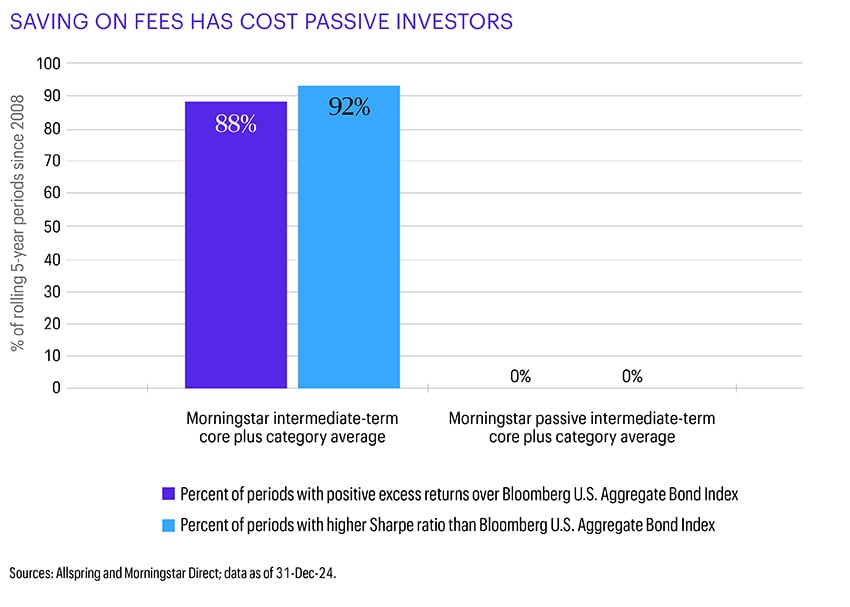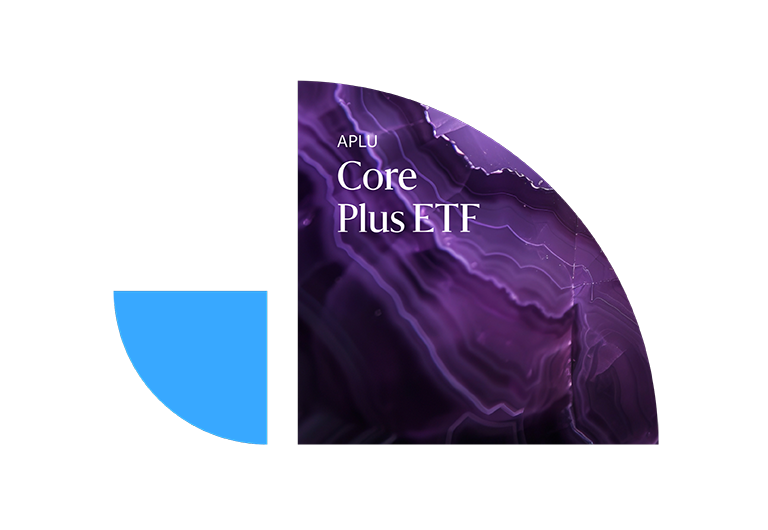Allspring fixed income capabilities
Riding the Curve
Riding the curve allows fixed income investors to generate diversified returns across the yield curve and up and down the rating spectrum. Over time, higher income has typically resulted in better risk-adjusted returns for fixed income investors.

Our record
Our track record is evidence of our process
97%
Of representative fixed income composite assets outperformed (gross)
Relative to their corresponding benchmarks for the five-year period
86%
Of representative fixed income composite assets outperformed (net)
Relative to their corresponding benchmarks for the five-year period
80%
Of our U.S. fixed income mutual funds
Have at least one share class with a 4- or 5-star Overall Morningstar Rating*
Important information
What’s the Agg missing? Passive investors can only take what the index offers
70% of the Bloomberg U.S. Aggregate Bond Index is comprised of relatively lower-yielding securities. With higher yields available over the past few years, passively holding the index means investors may be missing out on many sectors that have experienced higher total returns. Click on the below image to enlarge.

Index definitions can be found here.
The bigger picture: What's the real cost of bond investing?
Read more about the ways that active fixed income managers have structurally and persistently outperformed passive counterparts in the Allspring fixed income insights.

Does not include sales charges and assumes reinvestment of dividends and capital gains. If sales charges were included, returns would be lower. Performance data shown represents past performance and is no guarantee of, and not necessarily indicative of, future results. Gross performance does not take into account transaction costs, investment advisory fees, custody fees, or other expenses that were charged to clients’ accounts or deductions for income taxes. The pure gross of fees returns are supplemental information. After-tax returns are only applicable to taxable accounts. The net performance reflects the deduction of investment advisory fees charged to client accounts, as well as transactional fees. Such fees will reduce investment performance over time. Indexes are not investments and do not incur fees and expenses and are not professionally managed. It is not possible to invest directly in an index.
How do they do it? George Bory explains why active managers have consistently succeeded in fixed income. Watch now.

Invest for intermediate-term core-plus returns with Allspring Core Plus




Allspring Core Plus portfolio management team
Consistent, experienced team
- 25 years average industry experience
- 19 years average firm tenure
- $57.2 billion team assets under management
- $17.4 billion in team assets managing multisector bond strategies
Sector specialist model
Dedicated sector specialist portfolio managers engage in primary research and partner with traders and credit research analysts to uncover opportunities and unlock relative value
Flat organizational structure
- The same team members define and implement portfolio strategy
- Portfolio managers are engaged in the markets and close to the portfolio
Source: Allspring, figures as of September 30, 2025.
Follow our insights

For more complete information about Allspring Funds, click here for a current prospectus and, if available, a summary prospectus. Consider the investment objectives, risks, charges, and expenses of the investment carefully before investing. Please read it carefully before investing.
Investing involves risk, including the possible loss of principal. Bond values fluctuate in response to the financial condition of individual issuers, general market and economic conditions, and changes in interest rates. Changes in market conditions and government policies may lead to periods of heightened volatility in the bond market and reduced liquidity for certain bonds held by the fund. In general, when interest rates rise, bond values fall and investors may lose principal value. Interest rate changes and their impact on the fund and its share price can be sudden and unpredictable. Consult the fund’s prospectus for additional information on these and other risks.
It is possible that an active trading market for ETF shares will not develop, which may hurt your ability to buy or sell shares, particularly in times of market stress. Shares may trade at a premium or discount to their net asset value in the secondary market. These variations may be greater when markets are volatile or subject to unusual conditions. There can be no assurance that active trading markets for the shares will develop or be maintained by market makers or authorized participants. Shares of the ETFs are not redeemable with the ETF other than in creation unit aggregations. Instead, investors must buy or sell the ETF shares in the secondary market at market price (not net asset value) through a broker-dealer. In doing so, the investor may incur brokerage commissions and may pay more than net asset value when buying and may receive less than net asset value when selling. Investing involves risk, including the possible loss of principal. Bond values fluctuate in response to the financial condition of individual issuers, general market and economic conditions, and changes in interest rates. Changes in market conditions and government policies may lead to periods of heightened volatility in the bond market and reduced liquidity for certain bonds held by the fund. In general, when interest rates rise, bond values fall and investors may lose principal value. Interest rate changes and their impact on the fund and its share price can be sudden and unpredictable. High yield securities and junk bonds have a greater risk of default and tend to be more volatile than higher-rated securities with similar maturities. Mortgage- and asset-backed securities may decline in value and become less liquid when defaults on the underlying mortgages or asset occur and may become volatile in periods of rising interest rates. Foreign investments are especially volatile and can rise or fall dramatically due to differences in the political and economic conditions of the host country. These risks are generally intensified in emerging markets. Consult the fund’s prospectus for additional information on these and other risks.
The Morningstar Rating™ for funds, or star rating, is calculated for managed products (including mutual funds, variable annuity and variable life subaccounts, exchange-traded funds, closed-end funds, and separate accounts) with at least a three-year history. Exchange-traded funds and open-ended mutual funds are considered a single population for comparative purposes. It is calculated based on a Morningstar risk-adjusted return measure that accounts for variation in a managed product's monthly excess performance, placing more emphasis on downward variations and rewarding consistent performance. The Morningstar Rating does not include any adjustment for sales loads. The top 10% of products in each product category receive 5 stars, the next 22.5% receive 4 stars, the next 35% receive 3 stars, the next 22.5% receive 2 stars, and the bottom 10% receive 1 star. The Overall Morningstar Rating for a managed product is derived from a weighted average of the performance figures associated with its 3-, 5-, and 10-year (if applicable) Morningstar Rating metrics. The weights are: 100% 3-year rating for 36-59 months of total returns, 60% 5-year rating/40% 3-year rating for 60-119 months of total returns, and 50% 10-year rating/30% 5-year rating/20% 3-year rating for 120 or more months of total returns. While the 10-year overall star rating formula seems to give the most weight to the 10-year period, the most recent 3-year period actually has the greatest impact because it is included in all three rating periods. The Morningstar Rating is for this class only; other classes may have different performance characteristics. Past performance is no guarantee of future results.
Some of Morningstar’s proprietary calculations, including the Morningstar Rating™, are not customarily calculated based on adjusted historical returns. However, for new share classes/channels, Morningstar may calculate an extended-performance Morningstar Rating. The extended performance is calculated by adjusting the historical total returns of the oldest share class of a fund to reflect the fee structure of the younger share class/channel, attaching this data to the younger share class’s performance record, and then compounding the adjusted plus actual monthly returns into the extended-performance Morningstar risk-adjusted return for the 3-, 5-, and 10-year time periods. The Morningstar risk-adjusted returns are used to determine the extended-performance Morningstar Rating. The extended-performance Morningstar Rating for this fund does not affect the retail fund data published by Morningstar, as the bell curve distribution on which the ratings are based includes only funds with actual returns. The Overall Morningstar Rating for multi-share funds is based on actual performance only or extended performance only. Once the share class turns three years old, the Overall Morningstar Rating will be based on actual ratings only. The Overall Morningstar Rating for multi-share variable annuities is based on a weighted average of any ratings that are available.
While the inclusion of pre-inception data in the form of extended performance can provide valuable insight into the probable long-term behavior of newer share classes of a fund, investors should be aware that an adjusted historical return can provide only an approximation of that behavior. For example, the fee structures of a retail share class will vary from that of an institutional share class, as retail shares tend to have higher operating expenses and sales charges. These adjusted historical returns are not actual returns. The underlying investments in the share classes used to calculate the pre-performance string likely will vary from the underlying investments held in the fund after inception. Calculation methodologies used by Morningstar may differ from those applied by other entities, including the fund itself.
© 2025 Morningstar. All rights reserved. The information contained herein is proprietary to Morningstar and/or its content providers; may not be copied or distributed; and is not warranted to be accurate, complete, or timely. Neither Morningstar nor its content providers are responsible for any damages or losses arising from any use of this information.





